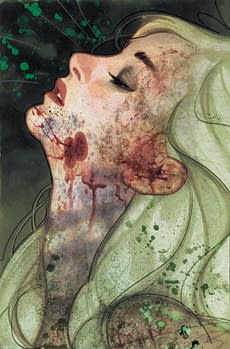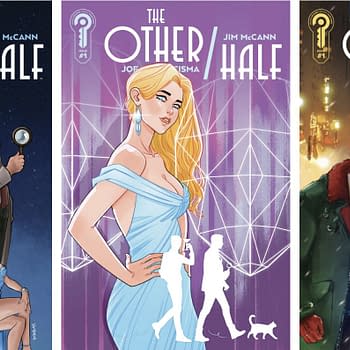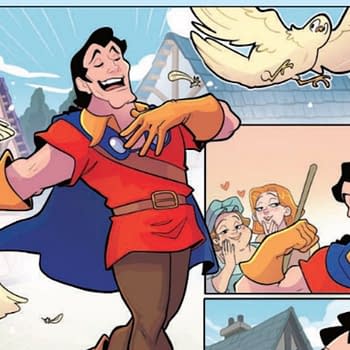Posted in: Comics, Recent Updates | Tagged: bill willingham, Comics, dc, fairest, vertigo
Review: Fairest #11
I like the quiet epics. The stories that explode and dazzle but remain under the radar, even when bearing the greasy fingerprints of The Big 2 on the pay stubs. Garth Ennis has been crafting a quiet epic with his series and thinking back on other recent runs that didn't seem to set the world on fire like they should've, I'd also throw Nick Spencer's T.H.U.N.D.E.R. Agents on that list as well. Stories that are complex and layered, stories that deal with huge themes and personal dramas, I love the quiet epics.
Now say what you will about Bill Willingham, the man is nothing if not smart. While I may sometimes find myself at odds with his political beliefs he always manages to keep such a talented, interesting assortment of creators and artists around him that repulsion from his thoughts is deflected by attraction to his crew. Bringing Shawn McManus on board was a brilliant move, he's also given love to writers like Matt Sturges and Chris Roberson, and of course those gorgeous Hughes covers for Fairest. And Fairest is what I wanted to talk to you about. Specifically this most recent story arc written by veteran author (yet comics newb) Lauren Beukes and illustrated by Inaki Miranda.
The most recent issue in the story came out this past week, #11, "The Hidden Kingdom Chapter Four: The Bad Sleep Well", the issue's title a reference to a superb Kurosawa post-war revenge flick. I mention the title's roots not only to show you that I'm cultured but also to draw a parallel between that story and this, for both tales involve dirty politics, bad blood and long grudges. And both take place in Japan! And I could see Ryogan being played by Toshiro Mifune. I've enjoyed the story so far but haven't felt the need to really write about it until now, until this issue.
From the start this story was a little darker than the other tales that have so far been told under the Fairest title and it's central character, Rapunzel, being one of the Fables characters that isn't necessarily in big rotation as far as the central cast of characters go. In this way Beukes immediately delivers something exciting or at the very least interesting, spinning a tale in the mundy world and spending some time with the Japanese Yokai. Fables has always celebrated world folk lore and while the majority of the story's action obviously takes place with the European tradition of fairy tale characters there has always been a constantly changing international cast helping entertain as well as inform on a myriad of cultures and beliefs.
This tale is such a brilliant balance of real emotional distress, kinetic and exciting action, political fable and horror story. The most recent issue being especially the latter. Rapunzel was attacked by a flock of flying paper cranes and on one of them was written something in Japanese about her children. She leaves for Japan with her Raven & Stylist Joel and Jack of Fables (because this takes place in the past, giving an even fuller ensemble of Fables to choose from)(it's really so nice seeing Blue again. ::tear::) and along the way we begin to see flashes of Rapuzel's life. It's a life of pain, a life of triumph, a life of escape and a life of horror. Real horror, not "I Know What You Did Last Summer" horror, but being dosed while in labor and having a witch convince you your newborns are dead while she steals them horror. Making a fort in the woods out of your hair since you can't find a place to live horror. Real horror. And in #11 it gets so much worse. We learn the truth about Rapunzel's children, well at least the children who have called her this time, the jury's still out on whether or not her actual babies are still alive or what. We learn the truth about the beautiful ninja woman with a mouth that would make Kakihara blush.
To say nothing of the art would be offensive, for Miranda does an incredible job for this is a story that requires a constantly shifting milieu, from the candy colored glow of Shibuya to the end of the world and the Hidden Kingdom, Miranda is able to capture both with skill and subtle grace. Miranda makes the characters come alive in their lust, their pain and their human like sadness. #11 contains some of his best work yet, especially the last two pages, both splashes where the words and the art merge together perfectly. The pages themselves, both featuring just Rapunzel allow us to really see what this character is made of and in those two pages everything we know about her clicks into place.
If you didn't read the earlier Fairest issues because you weren't sure if you were going to like it or thought you didn't want to just read another Fables title, I hope you'll give Beukes & Miranda's story a chance. It's different from the other Fables minis you've picked up and it can easily stand on it's own as exciting, intelligent comic book literature.












